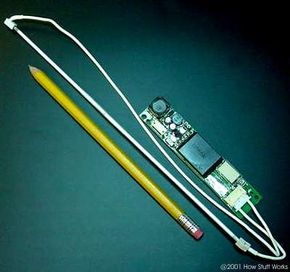Most computer Liquid Crystal Display (LCD) panels are lit with built-in fluorescent tubes above, beside and sometimes behind the LCD. A white diffusion panel behind the LCD redirects and scatters the light evenly to ensure a uniform display. This is known as a backlight.
A fluorescent light is most often a long straight glass tube that produces white light. Inside the glass tube there is a low-pressure mercury vapor. When ionized, mercury vapor emits ultraviolet light. Human eyes are not sensitive to ultraviolet light (although human skin is). The inside of a fluorescent light is coated with phosphor. Phosphor is a substance that can accept energy in one form and emit the energy in the form of visible light. For example, energy from a high-speed electron in a TV tube is absorbed by the phosphors that make up the pixels. The light we see from a fluorescent tube is the light given off by the phosphor coating the inside of the tube. The phosphor fluoresces when energized, hence the name.
Advertisement
A typical laptop display uses a tiny Cold Cathode Fluorescent Lamp (CCFL) for the backlight. One of these small tubes is able to provide a bright white light source that can be diffused by the panel behind the LCD. In addition to providing ample light, CCFLs do not rise far above the ambient temperature. This makes them ideal for LCD panels since the light source is in close proximity to other components that could be ruined by excessive heat.
One amazing thing about these lamps is their incredible size. They are very thin and the board that drives the lamp is very small as well. However, it is not that hard to break them, which is why your display may go dark if you drop your laptop.
Here are some interesting links:
Advertisement
